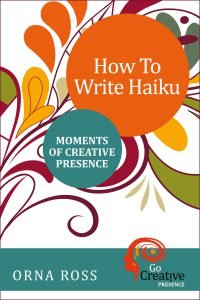 Reading and writing haiku is a practice, it brings us into creative presence. And that's the intention of this guide about how to write haiku.
Reading and writing haiku is a practice, it brings us into creative presence. And that's the intention of this guide about how to write haiku.
“Haiku happen all the time,” says Bill Higginson, who wrote The Haiku Handbook, another book about how to write haiku, these short poems about surfaces that have such a long, deep reach.
“Wherever there are people who are ‘in touch’ with the world of their senses, and with their own feeling response to it.”
Haiku happen. That’s it, that’s the movement. It’s a happening, not a willed activity.
No straining for effect. No pen chewing. A moment rises out of the many possible moments in the flowing stream of life, and is filtered through the subjectivity, of the writer’s perceiving mind.
The writer then tells what was seen and tasted, heard and inhaled, touched and felt.
When such sense impressions are expressed in carefully chosen words, artfully arranged, we call it poetry. When the shape of that arrangement is a pattern of 3-7-3 or 5-7-5 syllables, or similar, we call it a haiku.
How To Write Haiku: A Verbal Photograph
Some see haiku mainly as a branch of poetry, but for many others, and I am one of those, it’s not just a literary form but a source of philosophical inspiration, part of a zen-inspired, consciously creative lifestyle.
For me, a poem is always a key, unlocking clock time, opening out the surface of material reality to reveal the infinite wells of another reality that underlie our lives.
Poetry brings us into creative presence, makes us aware of these creative depths.
If the words don't create that shift, that moment of creative presence that Joyce called an “epiphany”, poetry hasn't happened.
A haiku does this through the lens of a single, personal experience of a single, personal moment.
When we read these short poems–if their few words are well chosen and we read with receptivity–we see or hear or smell or taste or touch the moment described.
The external sense impressions curl around our inner senses of memory, emotion, intuition, perception and imagination and soak into them, like mist.
This is an intimate and magical connection with time and place as experienced by the poet.
And—in the best haiku—with the poet’s sense of life and how it is lived.
How To Write Haiku: Creative Presence
Writing and reading haiku cultivates mindfulness and creative presence. It's an act of transcription.
The moment gives us the poetry, as it is created through us. Then the haiku expresses the poetry, gives us a kind of verbal photograph, with full creative awareness of what we are experiencing.
Every place, every moment in time, is full of poetry. All we have to do is open up to it, allow it, express it.
Haiku remind us that poetry is always possible.
I write haiku every day and post regularly to Instagram with an accompanying photograph snapped withe my phone.
How To Write Haiku: Your Turn
Now Your Turn: Capture a moment of creative presence: Write a 3-7-3 or a 5-7-5 haiku. Here’s how.
- Use the 13 or 17 syllables to give a short summation of a moment: what you saw, heard, touched, tasted or smelled.
- Turn the moment in time into an image.
- Don’t tell us what happened, show us.
- Don’t tell us how you felt. Trust the images, the sense perception, to hold the emotion. A good haiku conveys a mood, without mentioning the person or mood.
- Every place, every moment in time, is full of poetry. All we have to do is open up to it, allow it, express it.
Poetry is always possible.
Haiku On Instagram: Most days I share my #creativemoments on Instagram. I’d love to know about yours. Share a picture of something you’ve made, an experience you’ve enjoyed, or a moment of creative presence. To ensure I see your posts, hashtag #creativemoments or #gocreative and tag me: @ornaross
You can become a poetry patron for less than $2 a month and receive poetry, including haiku, written exclusively for you.

